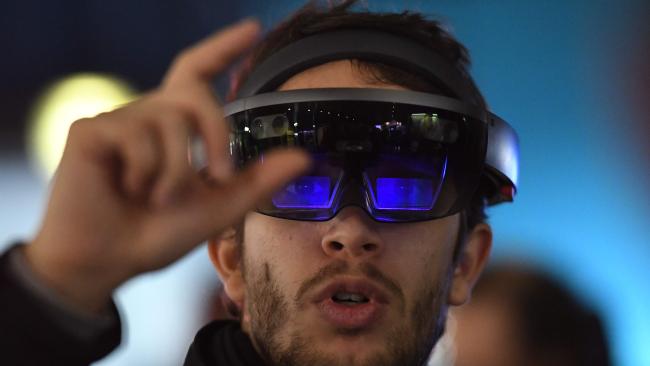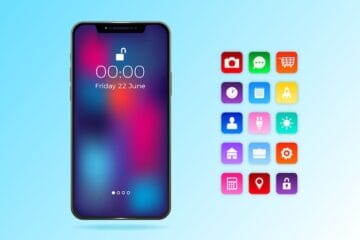The year is 2023. You walk into your local Carphone Warehouse and are greeted not by the usual menagerie of smartphones but instead by row after row of chunky spectacles. This is not a prediction of a merger between the mobile phone retailer and Specsavers but a vision of something more far-reaching: the end of the smartphone.
When the late Apple boss Steve Jobs unveiled the iPhone a decade ago, it marked the beginning of an era in which the little rectangles in our pockets would come to dominate our lives. That time is nearing its end.
In their place will be technology loosely called “spatial computing”: holograms, emails, photos, calendar reminders, YouTube videos and even — the horror! — banner ads projected onto your field of vision by smart, augmented-reality (AR) glasses.
Smartphones will no longer be the digital be-all and end-all. Instead they will be relegated to a piece of hardware hidden from view, housing the computing power required to produce what is appearing before your eyes.
This is the growing consensus among the technorati, anyway. No more peering at your mobile. Keyboards will be obviated by voice recognition software, so there will be no need for your laptop either. In short, the world in front of you will be your desktop.
It may sound outlandish, but in a recent interview Tim Cook, chief executive of Apple, compared the dawn of AR to the launch of the iPhone in 2007. “I think AR is that big. It’s huge,” he said. “With AR you cannot be engrossed in something but have it be a part of your world, of your conversation. That has resonance.”
AR is not to be confused with virtual reality, which requires clunky headsets that close you off from the outside. AR overlays images on the real world.
The Silicon Valley rumour mill has it that Apple will launch its first iPhone with built-in AR in June. Its line of smart glasses, says Shel Israel, a tech evangelist who has written a book on the subject, will come next year.
Apple, which declined to comment, would not be the first to test these waters. Last year Lenovo launched the Phab 2 Pro, a phone that, thanks to an extra camera and Google’s Tango software, has the equivalent of depth perception and takes AR to a new level of realism. Microsoft has also released a limited number of its HoloLens AR headsets. Facebook, Google and even Amazon are thought to be working on AR glasses for release next year.

If this sounds familiar, there is a reason. Google Glass, a first, disastrous go at this idea, was unveiled in 2013. It was panned for its terrible looks, limited functions and alarming privacy implications. Those who dared to wear a pair in public were dubbed “Glassholes”.

Four years, though, is an eternity in the tech world. The industry’s biggest beasts, as well as a crop of start-ups, have been churning billions of pounds into AR.
“Headsets of today are to Google Glass as the modern car is to the horseless carriage,” says Israel.
“In five years the hardware won’t be called AR or VR or even mixed reality. They will simply be smart glasses, and people will use them in the near tomorrow in the same ubiquitous ways that they use their phones today.”
In an office near a California retail park I have the world in my hands. A three-dimensional globe has appeared out of thin air in front of me. It spins slowly. I swipe at the air and the rotation quickens. Then Earth disappears. In its place pops up a hologram of a brain, pulsing with firing synapses. I pull at it and it triples in size. I walk inside, poking around the cerebellum. Then it too is gone, leaving me with a desk and an enthusiastic techie with designer stubble.
Ryan Pamplin, an executive at Meta Company, the California developer of the headset that I have just tried out, gushes: “What you just experienced is the most immersive augmented-reality experience on the planet today.” I feel he should get a gold star for effort — or perhaps a hologram of one.
The experience is undeniably impressive, though. Spend a few minutes manipulating highly detailed holograms with simple hand movements and it is not hard to see how this could be applied to just about anything, from industrial design to everyday life. Replace the pulsing brain, for example, with your inbox, where you could dictate your emails and discard any spam with a swipe of your hand.
Pamplin reckons this future is closer than most of us realise. Yet huge hurdles remain before you or I will be wearing these things.
Meta’s headset, the sleekest and cheapest ($US949) available today, is cumbersome. It is a visor that hangs over your eyes from a skull-hugging chassis and it must be plugged in.
Pamplin points out that Meta is focusing on industry first — “This is a tool, not a toy” — but says the company will reduce the headset to a strip of glass over your eyes in “three to five years”.
Fifty kilometres up the road a start-up called Vue is working on another bit of kit. The company is developing spectacles that use bone conduction to transmit sound through tiny pads on the arms of the glasses. It is jarring to hear music playing when you have no earphones on, but it works. A mic over the bridge of the nose lets you ask a personal assistant such as Apple’s Siri to order dog food or make a phone call.
There is of course a darker side to all this. Privacy remains a vexing issue that breathless techies and executives seem unwilling or unable to address. The next generation of spectacles will be able to record and photograph what you see far more effectively than Google Glass could. In other words, as the technology gets slicker, the privacy will get worse.
Israel lays out the pitfalls: “Smart glasses will know their owners far better than the people dearest to those wearers.
“Your glasses will know who you are, where you are, what you look at and for how long. It will remember this data. This will be useful to users, but how that data is used — by governments, marketeers, divorce lawyers — has dark implications.”
That is only the start. It is not hard to envisage your entire field of view being cluttered by banner ads and pop-ups. Several companies, including Meta, are working on industry-wide guidelines in the hope of averting the worst abuses, but it feels somehow inevitable that the technology, especially in the early years, will outrun the rules.
Perhaps most disturbingly, we may one day be able to gloss over the world entirely, according to Jon Peddie, a technology researcher: “You’ll be able to say: I don’t want to see homeless people; I don’t want to see graffiti or trash in the street.
“There are limits to this technology today, but it will get there. With lightning speed you’ll be able to erase what you are seeing and reconstruct the world as you’d like it to be.”
Digital rose-tinted glasses — somehow that doesn’t feel like progress.
[sOURCE:-THEAUSTRALIAN]





